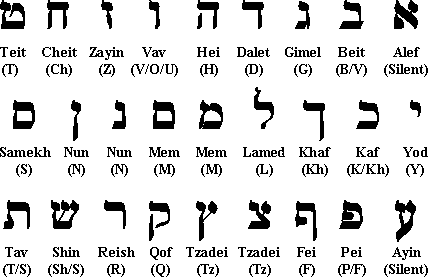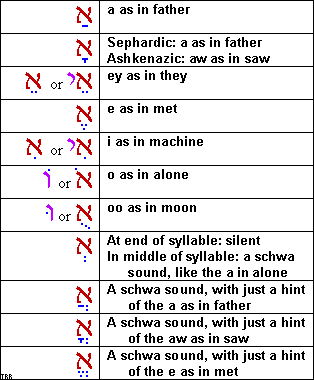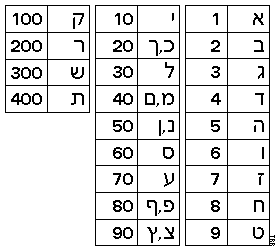Hebrew Alphabet
- Hebrew uses a different alphabet than English
- Hebrew is written right-to-left
- The Hebrew alphabet has no vowels, but pronunciation aids are often added
- There are several styles of Hebrew writing
- Hebrew letters have numerical values
- Writing in Hebrew may require a special word processor and fonts
The Hebrew and Yiddish languages use a different alphabet than English. The picture below illustrates the Hebrew alphabet, in Hebrew alphabetical order. Note that Hebrew is written from right to left, rather than left to right as in English, so Alef is the first letter of the Hebrew alphabet and Tav is the last. The Hebrew alphabet is often called the "alefbet," because of its first two letters.

Table 1: The Hebrew Alphabet
If this sounds like Greek to you, you're not far off! Many letters in the Greek alphabet have similar names and occur in the same order (though they don't look anything alike!): Alpha, Beta, Gamma, Delta ... Zeta ... Theta, Iota, Kappa, Lambda, Mu, Nu ... Pi ... Rho, Sigma Tau.
The "Kh" and the "Ch" are pronounced as in German or Scottish, a throat clearing noise, not as the "ch" in "chair."
Note that there are two versions of some letters. Kaf, Mem, Nun, Pei and Tzadei
Vowels and Points
Like most early Semitic alphabetic writing systems, the alefbet has no vowels. People who are fluent in the language do not need vowels to read Hebrew, and most things written in Hebrew in Israel are written without vowels.
However, as Hebrew literacy declined, particularly after the Romans expelled the Jews from Israel, the rabbis recognized the need for aids to pronunciation, so they developed a system of dots and dashes called nikkud (points). These dots and dashes are written above, below or inside the letter, in ways that do not alter the spacing of the line. Text containing these markings is referred to as "pointed" text.
Most nikkud are used to indicate vowels. Table 2 illustrates the vowel points, along with their pronunciations. Pronunciations are approximate; I have heard quite a bit of variation in vowel pronunciation.
Vowel points are shown in blue. The letter Alef, shown in red, is used to illustrate the position of the points relative to the consonants. The letters shown in purple are technically consonants and would appear in unpointed texts, but they function as vowels in this context.

Table 2: Vowel Points
There are a few other nikkud, illustrated in Table 3.

Table 3: Other Nikkud
The dot that appears in the center of some letters is called a dagesh. It can appear in just about any letter in Hebrew. With most letters, the dagesh does not significantly affect pronunciation of the letter; it simply marks a split between syllables, where the letter is pronounced both at the end of the first syllable and the beginning of the second. With the letters Beit, Kaf and Pei, however, the dagesh indicates that the letter should be pronounced with its hard sound (b, k, p) rather than its soft sound (v, kh, f). See Table 3. In Ashkenazic pronunciation (the pronunciation used by many Orthodox Jews and by many older Jews), Tav also has a soft sound, and is pronounced as an "s" when it does not have a dagesh.
Shin is pronounced "sh" when it has a dot over the right branch and "s" when it has a dot over the left branch.
Vav, usually a consonant pronounced as a "v," is sometimes a vowel pronounced "oo" as in "food" (transliterated "oo" or "u") or "oh" as in "Oh!" (transliterated "o"). When it is pronounced "oo," pointed texts have a dagesh (though sometimes, Vav with a dagesh is pronounced "v"). When it is pronounced "oh," pointed texts have a dot on top (though sometimes, Vav with a dot on top is pronounced "vo").
Illustration 1 is an example of pointed text. Nikkud are shown in blue for emphasis (they would normally be the same color as the consonants). In Sephardic pronunciation (which is what most people use today), this line would be pronounced: V'ahavtah l'reyahkhah kamokhah. (And you shall love your neighbor as yourself. Leviticus 19:18).
![]()
Illustration 1: Pointed Text
Styles of Writing
The style of writing illustrated above is the one most commonly seen in Hebrew books. It is referred to as block print, square script or sometimes Assyrian script.
For sacred documents, such as torah scrolls or the scrolls inside tefillin and mezuzot, there is a special writing style with "crowns" (crows-foot-like marks coming up from the upper points) on many of the letters. This style of writing is known as STA"M, an acronym for "Sifrei Torah, Tefillin and Mezuzot," which is where you will see that style of writing. For more information about the STA"M alphabet, including illustrations and relevant rules, see Hebrew Alphabet used in writing STA"M.
There is another style commonly used when writing Hebrew by hand, often referred to as Hebrew cursive or Hebrew manuscript. Table 4 shows the complete Hebrew alphabet in a font that emulates Hebrew cursive.

Table 4: Hebrew Cursive Font
Another style is used in certain texts, particularly the Talmud, to distinguish the body of the text from commentary upon the text. This style is known as Rashi Script, in honor of Rashi, the greatest commentator on the Torah and the Talmud. Rashi himself did not use this script; it is only named in his honor. Table 5 shows the complete Hebrew alphabet in a Rashi Script font.

Table 5: Rashi Script
K'tav Ivri: Ancient Hebrew Script
As mentioned above, the Hebrew alphabet that we use today is referred to as Assyrian Script (in Hebrew, K'tav Ashuri). But there was once another way of writing the alphabet that the rabbis called K'tav Ivri, which means "Hebrew Script." Many examples of this ancient way of writing the Hebrew alphabet has been found by archaeologists: on coins and other artifacts. It is quite similar to the ancient Phoenician writing. An example of this script is seen at Scripts of the Hebrew Language, side-by-side with other styles of Hebrew writing that were discussed above.
The rabbis of the Talmudic period were well aware of this ancient K'tav Ivri, and they raised the question whether the Torah was originally given in K'tav Ivri or K'tav Ashuri. A variety of opinions are expressed in the Talmud at Sanhedrin 21c-22a: one opinion states that the Torah was originally given in K'tav Ivri, but was changed to K'tav Ashuri in the days of Ezra, after the Babylonian Exile (the Babylonians, and consequently the Jews in exile, used K'tav Ashuri). Another opinion says that the Torah was written in K'tav Ashuri, but that holy script was denied the people when they sinned and was replaced with another one; when the people repented, the K'tav Ashuri was restored. A third opinion states that the Torah was always in K'tav Ashuri.
The general consensus is that the Torah was given in K'tav Ashuri, because the Talmud makes other references that don't make sense in K'tav Ivri. The Talmud talks about final forms of letters in the original Torah, but K'tav Ivri doesn't have final forms. It talks about the center of the Samekh and the Final Mem miraculously floating when the Ten Commandments were carved all the way through the tablets, but there is no Final Mem in K'tav Ivri, and neither Samekh nor Mem would have a floating center in K'tav Ivri as they do in K'tav Ashuri.
All authorities maintain that today, the only holy script is K'tav Ashuri. Any torah scrolls, tefillin or mezuzot must be written in K'tav Ashuri, and specifically in a style of K'tav Ashuri known as STA"M, discussed above.
K'tav Ivri is understood to be in the nature of a font, like Rashi script, rather than in the nature of a different alphabet, like Greek, Cyrillic or Roman. The names of the letters, the order of the letters, and the numerical value of the letters are apparently the same in both K'tav Ashuri and K'tav Ivri; thus, any religious significance that would be found in the numerical value of words or the sequence of the alphabet is the same in both scripts. The only difference is the appearance.
Transliteration
The process of writing Hebrew words in the Roman (English) alphabet is known as transliteration. Transliteration is more an art than a science, and opinions on the correct way to transliterate words vary widely. This is why the Jewish festival of lights (in Hebrew, Cheit-Nun-Kaf-Hei) is spelled Chanukah, Chanukkah, Hanuka, and many other interesting ways. Each spelling has a legitimate phonetic and orthographic basis; none is right or wrong.
Numerical Values
Each letter in the alefbet has a numerical value. These values can be used as numerals, similar to the way Romans used some of their letters (I, V, X, L, C, D, M) as numerals. Table 6 shows each letter with its corresponding numerical value. Note that final letters have the same value as their non-final counterparts.
The numerical value of a word is determined by adding up the values of each letter. The order of the letters is irrelevant to their value: the number 11 could be written as Yod-Alef, Alef-Yod, Hei-Vav, Dalet-Dalet-Gimel or many other ways. Ordinarily, however, numbers are written with the fewest possible letters and with the largest numeral first (that is, to the right). The number 11 would be written Yod-Alef (with the Yod on the right, because Hebrew is written right-to-left), the number 12 would be Yod-Beit, the number 21 would be Kaf-Alef, the number 611 would be Tav-Reish-Yod-Alef, etc. The only significant exception to this pattern is the numbers 15 and 16, which if rendered as 10+5 or 10+6 would be a name of G-d, so they are normally written Teit-Vav (9+6) and Teit-Zayin (9+7).
Table 6: Values of Hebrew Letters

Table 6: Values of Hebrew Letters
Because every letter of the alphabet has a numerical value, every word also has a numerical value. For example, the word Torah (Tav-Vav-Reish-Hei) has the numerical value 611 (400+6+200+5). There is an entire discipline of Jewish mysticism known as Gematria that is devoted to finding hidden meanings in the numerical values of words. For example, the number 18 is very significant, because it is the numerical value of the word Chai, meaning life or living. Donations to Jewish charities are routinely made in denominations of 18 for that reason.
Click HERE for Hebrew Conversation

